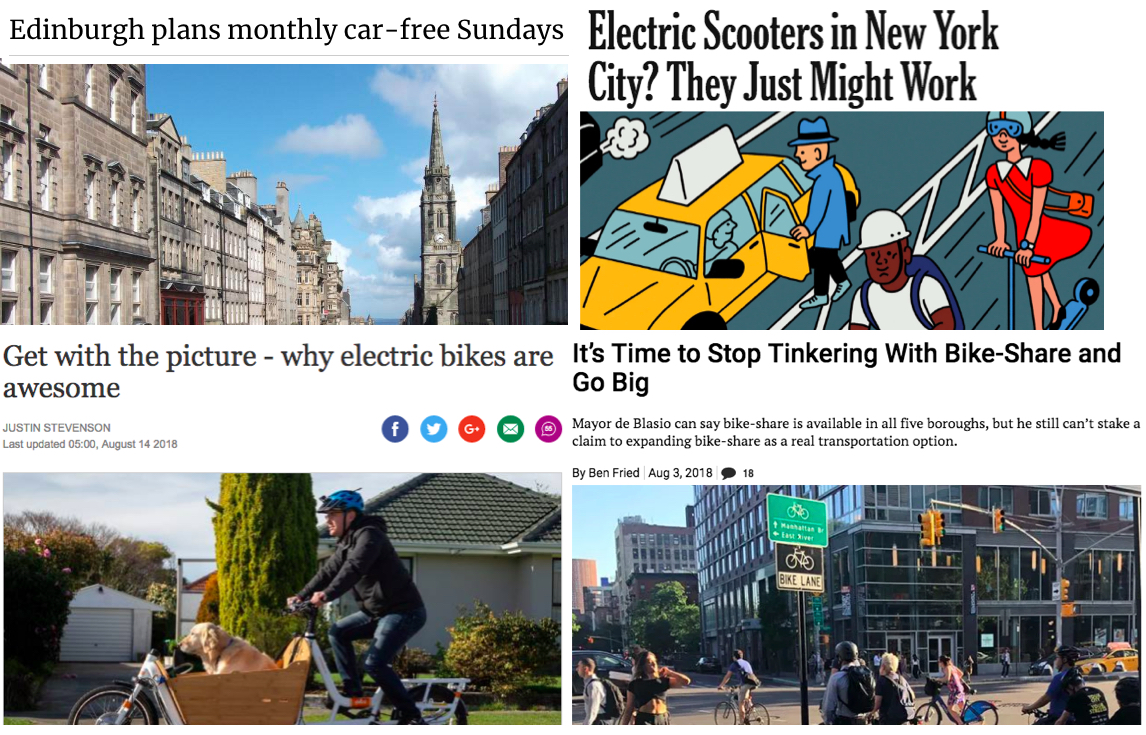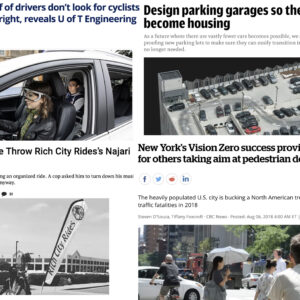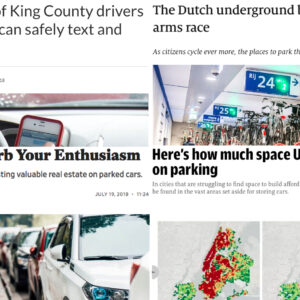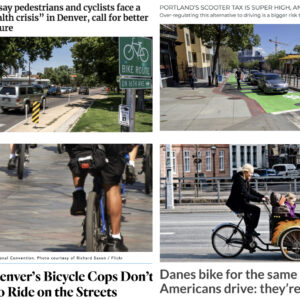Welcome to Monday.
I’m out of town at the moment on vacation with my family (typing this after everyone has gone to bed), so I’m even more grateful than usual for everyone who has flagged great stories for us this week. I’ll be back at 100% bike blogging power one week from today (8/27). Please hold down the fort while I’m gone.
Before we share the best stories from the past seven days, let’s give a shout-out to this week’s sponsor: Mark your calendar for September 2nd because Portland’s fun and fully-supported, multi-pub ride — the Tour de Lab — is coming!
And here are your stories of the week…
Portland’s future?: This article from Grist about e-bike share in Seattle is full of interesting nuggets and it’s framed through the lens of one of Lime’s 50 rebalancers.
East Portland history: Multnomah County Commissioner Jessica Vega Pederson shared an excellent and readable history (via a Twitter thread) of how Portland added its eastern territory. Remember this the next time we cover a project or issue that impacts people who live east of 82nd.
From gridiron to open road: Legendary retired NFL running back Emmitt Smith is a verifiable bike nut — he’s even started his own fondo event.
SUVs kill: Most of you have probably read about how SUVs are deadly by design — but we’re including this in the Roundup because it’s notable that the source this time around is the American Association for Retired Persons (AARP).
It’s the transit, stupid: While it’s good to see NYC limit ride-sharing vehicles and it’s also a positive sign to see talk of congestion pricing becoming more mainstream; at the end of the day, Bruce Schaller, former Deputy Commissioner of Traffic and Planning at the New York City Department of Transportation says, the best solution is to simply make transit better.
Advertisement
War on Cars Podcast: Three of the sharpest transportation reform activists we know — Sarah Goodyear, Doug Gordon, and Aaron Naparstek — have teamed up for a new podcast.
Checking in on “peak car”: “Owning a car is too expensive with all these alternatives around,” says more and more people who live in cities.
A big jump for bike share: Streetsblog NYC says the groundwork is there and the timing is right for the Big Apple to go bike for bike share.
All quiet on the scooter front: Besides a bit too much sidewalk riding, police in Dallas, Texas report that e-scooters and e-bike share are no big deal so far.
Scooter evangelism from the NY Times: The Times Editorial Board loves scooters and they want NYC’s Mayor to build more protected bike lanes for scooter riders to use.
Bike to birth: A New Zealand prime minister biked to the hospital to have her child and both love and hate that this is a major headline.
Portland should do this: In an effort to provide, “a legacy for future generations,” the city council of Edinburgh, Scotland will prohibit driving on one Sunday every month in parts of its downtown core and outlying commercial districts.
— Jonathan Maus: (503) 706-8804, @jonathan_maus on Twitter and jonathan@bikeportland.org
Never miss a story. Sign-up for the daily BP Headlines email.
BikePortland needs your support.







Thanks for reading.
BikePortland has served this community with independent community journalism since 2005. We rely on subscriptions from readers like you to survive. Your financial support is vital in keeping this valuable resource alive and well.
Please subscribe today to strengthen and expand our work.
Hope you have a great and well deserved vacation JM and for the forum you provide for all of use to bitch about stuff.
Quick comment on the New Zealand thing. The article doesn’t say that the prime minister biked to the hospital to give birth. It was actually the minister for women and associate minister for health and transport Julie Anne Genter.
Couldn’t say for sure, but this might be the link that goes with ‘It’s the transit stupid’:
https://www.washingtonpost.com/news/dr-gridlock/wp/2018/07/25/a-new-study-says-services-like-uberpool-are-making-traffic-worse/?noredirect=on&utm_term=.b0009aa38504
Bike to birth: The hospital (Kaiser Sunnyside) would only let us leave with our baby in a motor vehicle.
I ride to Interstate all the time, but I resist even DRIVING to Sunnyside. How would they know how you were getting home?
That’s awful. I suspect it’s also probably illegal, but who wants to hire a lawyer just to get out of the hospital.
Ha… now I want to have a baby just so I can leave the hospital on foot. Maybe I could borrow one?
A foot?
I guess I’m a lousy Google driver. What is the law that requires one to use a car to leave the hospital with a newborn? It’s clear that if you use a car, you must use a car seat, but I just couldn’t find any requirement that said one must use a car.
Since an infant cannot wear a helmet which is required by the State of Oregon even as a bike passenger then your only transportation choices are Walking or riding in a motor vehicle. I don’t know too many women who after giving birth would want to walk very far.
A friend wanted to walk his baby home from the hospital. His wife was going to be driven (they lived close, she had a C-section so walking was no-go). They wouldn’t let him walk her. I really don’t understand the legality of it. How is it possible for a hospital to mandate your transportation options?
I’m betting on the gray area between “wouldn’t allow” and “strongly discouraged”.
Many hospitals also mandate you be brought to their front door in a wheelchair, even if you are perfectly capable of walking. It’s all in the liability and strong desire not to readmit you because you tripped on the way home and tore out your stitches.
From the hospital’s standpoint, it makes perfect sense. Blame the lawyers and the actuaries.
This would make for an interesting article about why Kaiser Permanente Sunnyside Medical Center staff insist upon newborns leave within motor vehicles.
I was going to ride my bike home from my colonoscopy. I was informed that that was a really bad idea!
It’s quite simple. The hospital has a bat phone to child services who can take your babie with zero evidence of anything. And/or, make your life a living hell. So yeah, they can pretty much whatever do whatever they want.
You have two anesthesia options- fully out or light pain management so you can watch the procedure. How do I know? I accompanied a friend and he opted to watch the procedure. You probably still wouldn’t want to ride after that one, though.
Interesting development in the state of dockless transportation: I got an email the other day from Spin (one of the three dockless bikeshare companies in Seattle, for which I’d signed up back in January) saying they are getting out of the bikeshare business — so they can focus exclusively on scooters.
That’s right, they think scooters are the future. I can see why they would: I don’t recall Spin’s pricing, but Lime (which I use frequently) charges $2 for a one-hour ride on a conventional bike, versus $8.50 for a scooter or an e-bike. Despite the battery-charging hassles, there’s a lot more money to be made on electrified vehicles. And scooters are a lot cheaper than e-bikes, so there you go. Scooters it is, at least for one company.
This not to say I think e-scooters are the superior choice, by the way, just the obviously most-profitable solution at the moment.
Having ridden share-rigs a LOT this month (e-scooters in both Minneapolis and Portland, e-bikes in Seattle, and conventional bikes in Portland and Seattle), I can see the pluses and minuses of all three.
Personally, I prefer bikes (electric or non) to e-scooters if for no other reason than that bikes are active transportation, and give me exercise. But I’ll still take an e-scooter over a car for a “last-mile” or other short trip, and I think they’re a permanent addition to our transportation landscape.
In fact, this last week I’ve been in Portland, I’ve been using Lime scooters more, simply because the keypad situation with BikeTown bikes has become so frustrating. (By the way, I talked to a BikeTown rep at Sunday Parkways yesterday, who informed me they have started upgrading their bikes’ keypads and other electronics with parts that should work better).
More choices = good, especially if these are choices that get people out of cars, either directly or by allowing connections to transit to work better.
Re: scooters being a permanent fixture on our streets- I only hope PBOT shares your views. They’ve been pretty wonderful thus far.
From the ridesharing/transit article:
>>>
We should recognize the practical limits to [congestion] pricing. Even with $12.50 rush hour tolls on Hudson River tunnels, traffic backs up every morning and afternoon. Congestion pricing for Manhattan was expected to increase traffic speeds by 9 percent, only a fraction of the 22 percent decline in traffic speeds since 2012.
We all know about the political limits too. Congestion pricing has proven to be the steepest among all the hills we might choose to climb.
<<<
He then goes on to make the case (briefly) for improving transit. In short, he argues that making things better for people who are not driving is a more effective strategy than making things worse for people who are. And suggests congestion pricing may not be a panacea, and comes with a large political pricetag.
Wishful thinking?
The history of East portland I found extremely laughable, worthy of potus. I’m surprised how often the Oregonian was cited given their jingoistic support for annexation at the time and utter contempt for East Portland ever after, up though the present day. As early as the 1974 Downtown Plan had Portland strive to annex as much suburban area as possible, to use collected taxes to build their downtown pet projects like light rail and the bus mall. EP is still subsidizing inner Portland, according to county auditors, giving far more than they are getting back.
98% of EP annexation, aside from Lents (1913) and Pleasant Garden (1960s) was between 1986 and 1992, with only a few remnant acres added later on. The “plume” was in the underground water table, as the city has never used Columbia River water for drinking, and was later determined to be caused mostly by the aluminum smelters in Camas and Troutdale, agricultural chemicals, and a WW2-era munitions factory in what is now Argay and Parkrose, very nasty polluters.
When EP was annexed, most residences were already hooked up to underground household sewer systems, but they were part of the Hazelwood, Rockwood, and Powellhurst water districts, not City of Portland (now PWB), who each had contracts with either Troutdale or Portland for treating that sewage. Those few households not hooked up had septic systems in their (usually back) yards. It is extremely unlikely that they would collectively generate the “plume” outlined by the Oregonian. (Rockwood is still a separate water district by the way, giving their Portland residents the lowest rates in the entire city by a large margin.)
And of course the city promised much more by annexing EP, promising to build streets, sidewalks, etc. Much of which they still haven’t done.
In many ways East Portland is like Washington DC: they pay lots in property and gas taxes, but get no representation at city hall. Taxation Without Representation.
Actually, ODEQ and Multnomah County Health Dept did a study which documented the widespread impacts of septic system / sewage contamination in the shallower aquifer in the Columbia South Shore area, which at the time was being used for municipal water supply by the Park Rose Water District (also since annexed by Portland); this was the driver behind the 1990’s sewer project, and not groundwater contamination from Camas, the Troutdale smelter or the Boeing-Cascade site.
The Park Rose aquifer was affected by high nitrate levels (from the septage) and was also the site of the first detections of the volatile organic contaminant PCE in the metro area. Park Rose WD installed several air strippers to lower the PCE levels in the water they were serving. After annexation, Portland continued to use the Park Rose wells intermittently as part of their back up groundwater system until 1999. They have since been decommissioned and are no longer in service, and the shallow affected aquifer is no longer used by Portland for supply.
The aquifer has slowly recovered since the septic systems were replaced; however, the Village of Maywood Park is still on septic systems and is not connected to the sewer or to a municipal waste water treatment plant, and so continues to contribute to the problem.
David, well stated. I’ve been a resident out here for almost two decades now and have seen it do nothing but decline in livability. Until our current form of ineffective city government is completely removed I don’t see the trend changing out here any time soon unfortunately.
It was laughable to see Wheeler out here recently at the Gateway Fred Meyer store posing for a photo op. He’d probably never step foot out here otherwise.
Really? I thought this was a hot area for new gentrification?
Not that I’m a fan of gentrification, but that’s sure news to me. All I’ve seen is businesses closing and more homeless problems. Sure people are moving here but it’s more out of desperation than desirability. Safeway just closed since it was robbed blind thanks to the Hansen Shelter across the street. Oh well at least we’ve got a couple Winco’s and Gateway Freddy’s, but who knows how much longer they will stay around.
Safeway at SE 122nd & Powell? Or the one at 122nd & Glisan? Either way, that’s a disaster, as Albertsons long ago pulled out at 122nd & Division. Fewer choices = higher prices.
David, yeah the 122nd and Glisan store. Gone. And you are right…less competition means higher prices to all the folks out here. Thanks Wheeler.
The city doesn’t use water directly from the Columbia. What was mentioned in the twitter thread was the Columbia South Shore Well Field, which is the city’s back up water source.
So Lime uses a fleet of 13 vans to re-balance the ebikes and replace depleted batteries. I would like to see how that impacts the energy and emissions that they bragged about reducing later in the article. It starts to smell a bit like greenwashing when big gas guzzling trucks move the bikes around and recharge them. I guess if you want to feel good about using the system don’t dig too deep into how it works.
Even more interesting would be how they get the juice to recharge the bikes. Is it by running the engine, essentially using it as an inefficient generator? Or using an in-vehicle fuel-based generator? I’d like to know if my electric bikes were in fact gasoline or diesel powered bikes.
They just plug them in. From the Grist article:
Here in the Pac NW, we chop up Salmon to make electricity. i-roll on Columbia-i
You forgot that we chop up salmon AND kill sea lions for trying to eat the few remaining salmon, in order to ship wheat to China and make “Green” electricity. Human powered transport is the way to go. At least those reading this blog will be ready for dwindling resources and forced petro/ electro transport abstinence.
I’ve a small nit to pick: dams here do perpetrate all sorts of mischief on salmon, but not by chopping them up.
That is indeed a small nit, since while they are not actually sliced-and-diced, most salmon mortality at the dams is due to the rotating steel blades of the turbines (impingement and/or decompression, and resulting predation). This is a pretty good article: https://www.nwcouncil.org/reports/columbia-river-history/damsimpacts
try this one from the same outfit: https://www.nwcouncil.org/reports/columbia-river-history/fishpassage
Columbia River dams have screens and other bypass arrangements to keep juvenile salmon out of turbines. they certainly aren’t 100% effective, but they at least protect many fish from the turbines if not from other injuries and predation.
I’m no friend of dams, by the way. quite the opposite.
Yes, that’s also a good article. Yes, stationary screens, traveling screens, bubble screens, sluice channels, tanker truck bypass, gatewell dipping, mandatory spill regimens, and more have all been tried, and some permanently implemented, to reduce smolt mortality at each dam. The fact remains that mortality at the dams is still very high (roughly 10% die at each dam they pass), and the vast majority of those deaths are due to the effects of passing through the turbines, whether or not that’s referred to as “chopping.”
I didn’t take you as a dam lover. 🙂
I’ll go along with that.
my–perhaps poorly phrased–objection was that mortality due to dams includes much more than mortality at dams. while I suspect the bulk of the harm to salmon caused by dams does not occur at or in the dam proper (with the exception of those that lack fish passage entirely), I will cop to ignorance on that score.
For sure dams cause lots of other mortal dangers for salmon! Submerged spawning beds, impeded travel time during critical smolting period, and increased predation due to impondments. Lately, the pinapeds at Bonneville preying on returning adults. It’s hard to weigh the environmental cost of a single adult mortality but it represents hundreds or thousands of juvenile deaths in terms of total health of the run (total return per [e^N] eggs, or fry, or smolt…). As you allude, it’s similarly hard to evaluate mortality at the dam itself compared to related factors, but various counting tools (branding, PIT-tagging, acoustics) do come up with similar results: the dams themselves – specifically the operating turbines – are the biggest point-source of mortality. Mitigation efforts try to address all those factors: hatcheries, screens for the turbines, spill regimen to bypass turbines and emulate spring freshets flushing smolt through impondments, fishing regulations including bounties on predators, and now killing sea lions.
That’s just dams; there are yet more human-influenced conditions that diminish salmon.
When I hear someone say “chopping up salmon,” my reaction is that while they may or may not be an expert on the topic, at least they’re aware that dams are the biggest reason why salmon runs have dwindled throughout the PNW, and that they may actually be very aware of the mechanisms by which that has happened.
you may run in more erudite circles than I do. when I have heard somebody say dams chop up salmon, it has turned out to be because somebody told them that dams are bad news for fish, but they don’t know (or care to know) much more than that. my sample size is, however, rather small.
13 vans to replenish hundreds of bikes doesn’t sound that terrible. Non-zero impact to be sure, and worth analyzing, but that doesn’t mean it’s as bad as driving an SOV around (both in terms of emissions and in contributing to congestion).
So much of this banter seems to de based on the assumption that scooting is substituting for driving (SOV in your telling). Do we know enough to to state this? I have my doubts.
It seems like these e scooters and e bikes are a kind of traffic time shifting scheme. They allow people to skoot or ride the last mile or so during the day, possibly reducing traffic during that period, but then they add a new traffic flow of juicers and rebalancing vans at night and in the wee hours. Not sure how sustainable these are if they depend on a late night fleet of happy motoring cowboys to keep them going. Are they fooling us in to thinking we have accomplished something only collapse in to a heap as the age of motoring fades away.
“SUV’s Kill…” uh, I think it’s the people driving them…
You obviously haven’t seen Stephen King’s excellent documentary Christine.
It’s the combination of the two.
Only 1958 Plymouth “Furys” were so blessed.
My 1965 Plymouth “Barracuda” and I never harmed anyone. To the contrary, we were brutally attacked 3 times, once by a lumber truck that put a load of reinforcing bars through that lovely rear window.
Sounded like a nuke! Any residual enchantment was blown away.
Mopar or No Car? ; ) I had a ’67 fastback and a ’68 coupe myself.
City-wide all-day Sunday parkways, anyone?
Just back from Seattle. All things bikeshare have really changed in the last year (And I am not talking Pronto)…Seattle has almost become a bike share desert – except for Lime Bikes, though seemly fewer on the street than before (more dispersed?) – now that OFO is way gone and SPIN has announced its retreat. No real crowing of sidewalks in the CBD or SODO or U District.
And I saw at least one Lime e-bike in the wild.
Two thumbs up on that podcast!